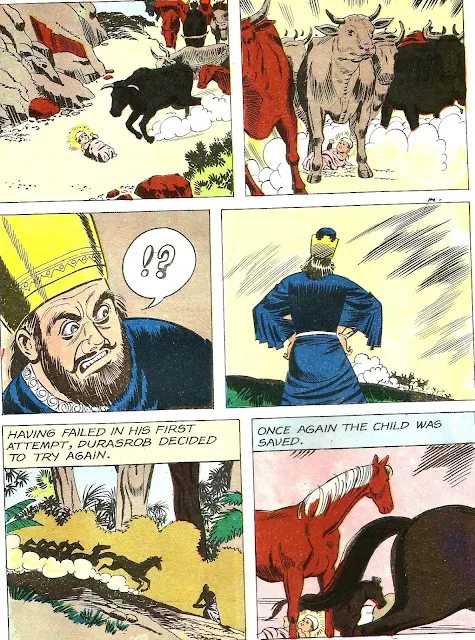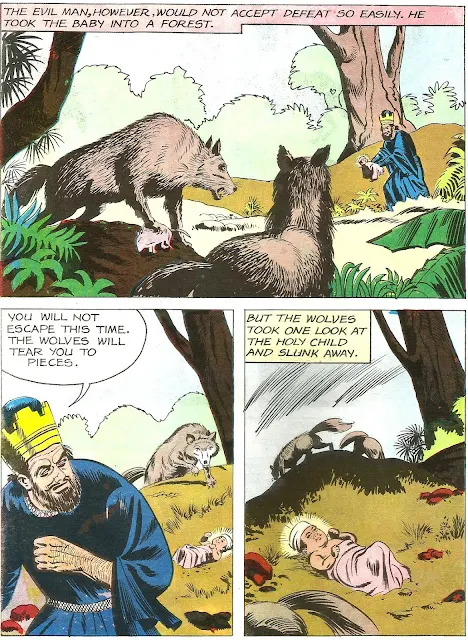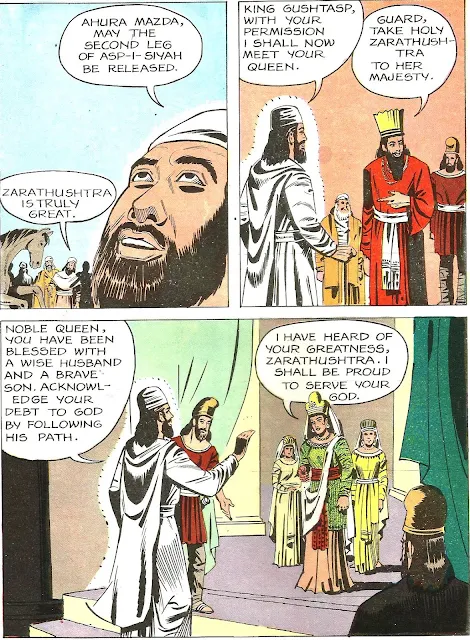 |
| Zarathustra Comics Cover |
 |
| Zarathustra |
Zarathustra:
Zarathustra (Greek Zoroaster): legendary religious teacher from Bactria, founder of Zoroastrianism.
Life of Zarathustra:
 |
| Modern portrait of Zarathustra, inspired by Ahuramazda's dress on a relief of Taq-e Bostan |
Hardly anything is known about Zarathustra's life. For example, it is uncertain when he lived. The ancient Greeks speculated that he lived six thousand years before the philosopher Plato and several scholars have argued for a date at the beginning of the sixth century BCE. Other scholars accept that Zarathustra is the author of the Gâthâ's (a part of the holy book of the Zoroastrians, the Avesta), which they date, on linguistic grounds, in the fourteenth or thirteenth century BCE.
It is also unclear where Zarathustra was born and where he spent the first half of his life. Every tribe that converted to Zoroastrianism made up legends about the prophet's life, and nearly all of them claimed that the great teacher was "one of them". On linguistic grounds, we may argue that author of the Gâthâ's belonged to a tribe that lived in the eastern part of Iran, in Afghanistan or Turkmenistan. This fits neatly with a tradition that connects Zarathustra with the ancient country named Bactria and a cypress at Kâshmar.
Zarathustra was born in Bactria (or Aria) as the son of a not very powerful nobleman named Purushaspa and a woman named Dughdhova. Zarathustra was the third of five brothers. He became a priest and seems to have showed a remarkable care for humans and cattle. The family is often called Spitama, which is a honorary title meaning 'most beneficient', but was later taken for a family name.
 |
| Stone Idol of Ahura Mazda |
A remarkable aspect of Zarathustra's teaching is that he employs special words to describe the demons. Their names are remarkably similar to words from the Indian Rigveda. Now it is reasonably certain that the language of the Rigveda was spoken in eastern Iran at some stage in the history of the second millennium BCE. We may assume that Zarathustra opposed the old religion, which was to flourish in the Punjab.
Finally, Zarathustra obtained asylum from a king named Hystaspes; he may have ruled in Chorasmia or Aria. At his court, the prophet debated with the priests of Mithra; on an official gathering, they discussed thirty three questions, and Zarathustra's opinions prevailed. According to legend, the cypress at Kâshmar (in northeast Iran) commemorates this event (or another important event). The Denkard tells more about this even.
Many noblemen followed the example of Hystaspes to convert to Zarathustra's new religion. From now on, Zarathustra lived at the court of Hystaspes, until he was killed at the age of seventy-seven by invading nomads. Some locate his death at Bactra (Balkh, near modern Mazâr-e Sharîf) in Afghanistan.
Zoroastrianism:
The oldest Parsi scripture is known as Gatha. Later on it came to be written in Zend meaning commentary and Avesta, which is the language in which it was later written. Thus it is now known as Zendavesta.
 |
| Zendavesta : Sacred Book of Parsi |
Zendavesta is divided in two parts:
The first part contains the Vendidad-a compilation of religious laws and stories, the Visperad-that contains litanies pertaining to sacrifice and the Yasna-also containing litanies and five hymns or Gathas in a special dialect.
The second part contains prayers and is known as Khorda Avesta or `small Avesta`.
 |
| Zend-Avesta - a collection of Zoroastrian texts |
Avestan Language Zendavesta was such a language that could not be understood by the people. Then the Parsi priests translated it into Pahlavi, which is the ancient form of Persian language. French, German and British scholars tried to understand the language of Gatha and Zendavesta .In the process it gradually dawned upon them that the language of Gatha and Zendavesta has a great kinship with Sanskrit language.
 |
| Parsi Navjote ceremony (rites of admission into the Zoroastrian faith). |
In Zoroastrianism, water (apo, aban) and fire (atar, adar) are agents of ritual purity, and the associated purification ceremonies are considered the basis of ritual life. In Zoroastrian cosmogony, water and fire are respectively the second and last primordial elements to have been created, and scripture considers fire to have its origin in the waters. Both water and fire are considered life-sustaining, and both water and fire are represented within the precinct of a fire temple. Zoroastrians usually pray in the presence of some form of fire (which can be considered evident in any source of light), and the culminating rite of the principle act of worship constitutes a "strengthening of the waters". Fire is considered a medium through which spiritual insight and wisdom is gained, and water is considered the source of that wisdom.
 |
| A Zoroastrian fire temple in Yazd, Iran. |
In Zoroastrianism, the Creator Ahura Mazda is all good, and no evil originates from him. Thus, in Zoroastrianism good and evil have distinct sources, with evil (druj) trying to destroy the creation of Mazda (asha), and good trying to sustain it. Mazda is not immanent in the world, and his creation is represented by the Amesha Spentas and the host of other Yazatas, through whom the works of God are evident to humanity, and through whom worship of Mazda is ultimately directed. The most important texts of the religion are those of the Avesta, of which a significant portion has been lost, and mostly only the liturgies of which have survived. The lost portions are known of only through references and brief quotations in the later works, primarily from the 9th to 11th centuries.
Zarathustra's teachings are strongly dualistic. The believer has to make a choice between good and evil. Zoroastrianism was one of first world religions to make ethical demands on the believers.
 |
| Parsee_Wedding_1905 |
While the Parsees in India have traditionally been opposed to proselytizing, probably for historical reasons, and even considered it a crime for which the culprit may face expulsion,Iranian Zoroastrians have never been opposed to conversion, and the practice has been endorsed by the Council of Mobeds of Tehran. While the Iranian authorities do not permit proselytizing within Iran, Iranian Zoroastrians in exile have actively encouraged missionary activities, with The Zarathushtrian Assembly in Los Angeles and the International Zoroastrian Centre in Paris as two prominent centres.
Faravahar is one of the best-known symbols of Zoroastrianism, the state religion of ancient Iran. This religious-cultural symbol was adapted by the Pahlavi dynasty to represent the Iranian nation.
Other Characteristics Zoroastrianism:
In Zoroastrian tradition, life is a temporary state in which a mortal is expected to actively participate in the continuing battle between truth and falsehood. Prior to being born, the urvan (soul) of an individual is still united with its fravashi (guardian spirit), and which have existed since Mazda created the universe. During life, the fravashi acts as a guardian and protector. On the fourth day after death, the soul is reunited with its fravashi, in which the experiences of life in the material world are collected for the continuing battle in the spiritual world. For the most part, Zoroastrianism does not have a notion of reincarnation, at least not until the final renovation of the world. Despite this, followers of Ilm-e-Kshnoom in India believe in reincarnation and practice vegetarianism, two principles unknown to Orthodox Zoroastrianism.
 |
| The Towers of Silence are circular-shaped buildings that have funeral customs and symbols for adherents of Zoroastrianism. |
In Zoroastrian scripture and tradition, a corpse is a host for decay, i.e., of druj. Consequently, scripture enjoins the "safe" disposal of the dead in a manner such that a corpse does not pollute the "good" creation. These injunctions are the doctrinal basis of the fast-fading traditional practice of "ritual exposure", most commonly identified with the so-called "Towers of Silence" for which there is no standard technical term in either scripture or tradition.
 |
| The only Tower of Silence still active is located in Mumbai, but even in India, Zoroastrian |
The practice of ritual exposure is only practised by Zoroastrian communities of the Indian subcontinent, where it is not illegal, but where alternative disposal methods are desperately sought after diclofenac poisoning has led to the virtual extinction of scavenger birds. Other Zoroastrian communities either cremate their dead, or bury them in graves that are cased with lime mortar.
Similarities between Hinduism and Zoroastrian:
1. Sacrificial rituals known as Yasnas in Zoroastrianism and Yajna in Hinduism.
2. Worship of gods bearing identical names such as Mithra and Yama or Yima.
3. Elements of both polytheism and monotheism.
4. Ritual chanting of manthra or mantras during religious ceremonies.
5. A three tier universe consisting of upper, middle and lower regions.
6. The concept of divine moral order called Arta or Asha in Zoroastrianism and Rta in Hinduism.
7. The conflict between good and evil forces with God on the side of the good forces.
8. The division of time into four periods in which good will progressively decline and evil would ascend to a point where God's intervention would become necessary.
9. God as protector and upholder of righteousness.
10. The concept of heaven and hell.
11. Death being viewed as the cause of impurities.























































 Online Movies
Online Movies
No comments:
Post a Comment